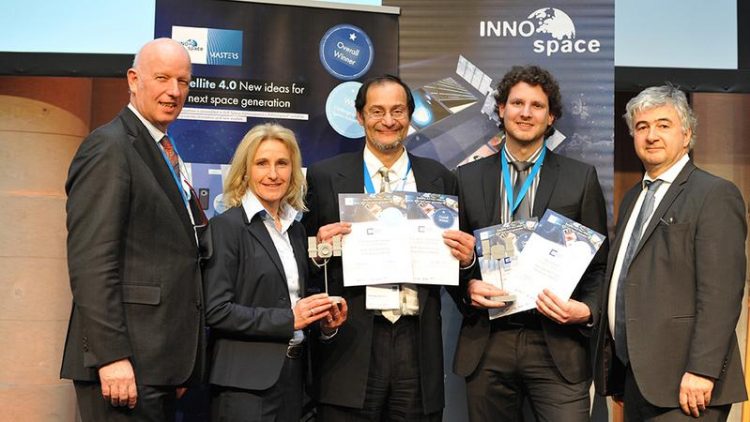The world's first wireless satellite

Sergio Montenegro (centre) and Tobias Mikschl with Wolfgang Scheremet, Federal Ministry for Economic Affairs (right), and Gerd Gruppe and Franziska Zeitler, both from the DLR Space Administration. (Photo: DLR / Simone Leuschner)
Professor Sergio Montenegro and his fellow researcher Tobias Mikschl have reason to be happy: A few days ago, the two computer scientists from the Julius-Maximilians-Universität (JMU) Würzburg in Bavaria, Germany, took to the podium in Berlin – as the overall winners of the INNOspace Masters competition and as winners of the category “DLR Space Administration Challenge”. DLR is the national aeronautics and space research centre of the Federal Republic of Germany.
What the price was awarded for: Montenegro and Mikschl developed Skith, a technology for the world's first wireless satellite. Previously, all single components of a satellite had to be interconnected using electric cables. Skith has changed that by using miniaturised high-speed real-time radio modules with short ranges. This reduces design effort and costs while boosting the satellite's technical reliability and flexibility.
Test in space planned for 2018
“The system is ready and waiting in our labs to be tested in space under real conditions,” says Mikschl. In 2018 already, Skith could hitch a ride on a satellite to be launched into space, allowing the system to prove how well it functions under real conditions.
Skith stands for “skip the harness”. As a reward for their innovation, Montenegro and Mikschl received a certificate, a satellite-shaped trophy and the invitation to apply for money with the DLR to fund new projects.
Facts about the competition
The DLR has organised the competition for the first time. Under the motto “Satellite 4.0”, participants were invited to submit suggestions and concepts for the future of aeronautics. 50 companies, universities and research institutions from eight European countries participated. In the end, nine finalists in three competition categories convinced the jury with their ideas. The awards ceremony took place at the INNOspace Masters Conference in Berlin on 4 May 2016.
The competition is organised by DLR Space Administration on behalf of the German Federal Ministry for Economic Affairs and Energy. The competition is part of the INNOspace initiative that has promoted innovations and technology transfers between astronautics and other industry sectors since 2013.
Contact
Prof. Dr. Sergio Montenegro, Head of the Chair of Computer Science VIII (Information Technology for Aerospace), University of Würzburg, montenegro@informatik.uni-wuerzburg.de
Tobias Mikschl, Chair of Computer Science VIII (Information Technology for Aerospace), University of Würzburg, Phone: +49 931 31-80031, tobias.mikschl@uni-wuerzburg.de
http://www.dlr.de/dlr/en/desktopdefault.aspx/tabid-10212/332_read-17704/#/galler… DLR press release on the competition
http://www8.informatik.uni-wuerzburg.de/startseite/ Link to the homepage of Prof. Dr. Sergio Montenegro
Media Contact
All latest news from the category: Information Technology
Here you can find a summary of innovations in the fields of information and data processing and up-to-date developments on IT equipment and hardware.
This area covers topics such as IT services, IT architectures, IT management and telecommunications.
Newest articles

A ‘language’ for ML models to predict nanopore properties
A large number of 2D materials like graphene can have nanopores – small holes formed by missing atoms through which foreign substances can pass. The properties of these nanopores dictate many…

Clinically validated, wearable ultrasound patch
… for continuous blood pressure monitoring. A team of researchers at the University of California San Diego has developed a new and improved wearable ultrasound patch for continuous and noninvasive…

A new puzzle piece for string theory research
Dr. Ksenia Fedosova from the Cluster of Excellence Mathematics Münster, along with an international research team, has proven a conjecture in string theory that physicists had proposed regarding certain equations….



